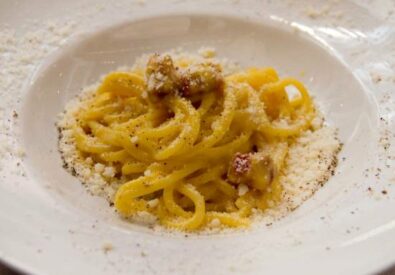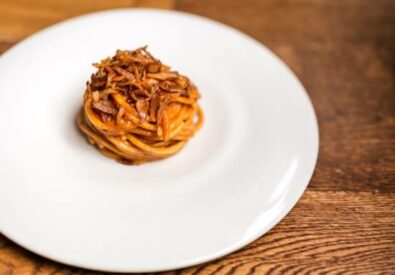EATERIES
CARBONARA
Pasta carbonara is the emblem of Roman cuisine.
This iconic dish combines eggs and Roman pecorino cheese, mixed vigorously until a velvety cream is obtained.
The final touch is provided by the local guanciale, crispy and flavorful, which adds an irresistible note.
The origins of carbonara are shrouded in mystery.
Some attribute it to the Carbonai (carbonari in Roman dialect), while others link it to American soldiers in World War II.
What is indisputable, however, is that the best carbonara is enjoyed in Rome!
RECOMMENDED LOCATION: Roscioli, Via dei Giubbonari 21

TONNARELLI CACIO E PEPE
Tonnarelli cacio e pepe is an iconic dish of Roman cuisine, featuring a creamy sauce of pecorino and black pepper.
Despite the simplicity of the ingredients, the preparation requires skill: the pecorino and pepper are added to the freshly cooked pasta and mixed with a little of its cooking water, stirring vigorously until a perfect consistency is achieved. The origins of this dish go back to shepherds, who carried essential ingredients such as pepper and sheep’s cheese with them during their travels.
When it was time to eat, they would cook the pasta over a makeshift fire and season it with cheese and black pepper, stirring vigorously.
Thus was born a dish that, even today, is a beloved symbol of Roman culinary tradition.
RECOMMENDED VENUE: Tonnarello, Straw Street, 1/2/3

GRICIA AND AMATRICIANA
Pasta alla gricia is considered an ancestral version of carbonara, but without the use of eggs.
This dish, which has older origins than carbonara, features three main ingredients: pecorino romano cheese, black pepper and guanciale bacon.
These elements combine to create a rich and flavorful sauce that makes gricia a true masterpiece of Roman culinary tradition.
RECOMMENDED LOCATION: Cesare al Casaletto, Via del Casaletto, 45
Amatriciana is often described as a gricia enriched with cherry tomatoes.
This dish takes its name from the town of Amatrice, famous for the quality of its guanciale, while remaining a mainstay of Roman culinary tradition.
With the introduction of tomatoes into Italian cuisine, amatriciana combined these fruits with classic Roman ingredients such as guanciale and pecorino cheese, creating a dish that, while maintaining similarities with gricia, has its own uniqueness and irresistible flavor.
RECOMMENDED LOCATION: Osteria Fernanda, Via Crescenzo Del Monte 18/ 24


ABBACCHIO ALLO SCOTTADITO
Abbacchio alla scottadito is a classic Easter dish, but also enjoyed throughout the year.
It consists of young lamb chops marinated and then grilled, characterized by a delicate flavor.
The name “scottadito” comes from the fact that it is eaten hot, so hot that it scalds the fingers.
Recommended venue: Hostaria Isidoro, Via di S. Giovanni in Laterano, 59/A

OXTAIL
Also known as “Quinto Quarto,” coda alla vaccinara is a typical Roman stewed oxtail dish.
Originating in Rione Regola, this dish includes oxtail cooked with onions, carrots, celery, wine and tomatoes, and sometimes raisins and pine nuts, with a slow cooking time of at least 4-5 hours.
Recommended venue: Trattoria Da Enzo al 29, Via dei Vascellari 29

ARTICHOKES AND CHICORY
Artichokes a la giudia and alla romana
Carciofi alla giudia are a specialty of Rome’s Jewish Ghetto, fried after being soaked in water and lemon.
Roman style artichokes, on the other hand, are cooked in a pan with garlic, parsley and mint, without frying.
Recommended venue: Armando al Pantheon, Salita de’ Crescenzi 31
Repassed chicory
Chicory ripassata is a simple side dish from Lazio cuisine, known for its strong flavor.
Chicory is first boiled and then repassed in a pan with oil, garlic and parsley.
Recommended venue: Trattoria La Rustica, Via Bolgheri 55


TRAPIZZINO, MARITOZZO AND SOUR CHERRY TART
Trapizzino
Invented in 2009 by Stefano Callegari, the Trapizzino is a white pizza pocket filled with Roman specialties such as chicken cacciatora or Roman-style tripe.
This tasty snack is available at several locations in Rome, other Italian cities, and even in New York City.
Recommended venue: Central Market, 36 Giovanni Giolitti Street
Maritozzo
In Roman times, maritozzo was a sweet bread with a gold ring or object inside as a token of love.
Today, it is a sweet bun filled with cream and dusted with powdered sugar.
There are also savory versions, ideal for lunches or appetizers.
Recommended venue: Regoli, historic bakery near Piazza Vittorio
Mistletoe Tartole
Sour cherry tart, a Jewish-Roman tradition, is made of short pastry with sour cherry jam and ricotta cream.
Sour cherries, a type of cherry with a tart flavor, make this dessert unique.
Created in the 18th century to circumvent papal bans on the sale of dairy products, the dessert is a true gem of Roman pastry making.
Recommended venue: Forno Boccione al Ghetto




SUBSCRIBE TO WHATSAPP CHANNEL DEDICATED TO JUBILEE 2025







Congratulation!